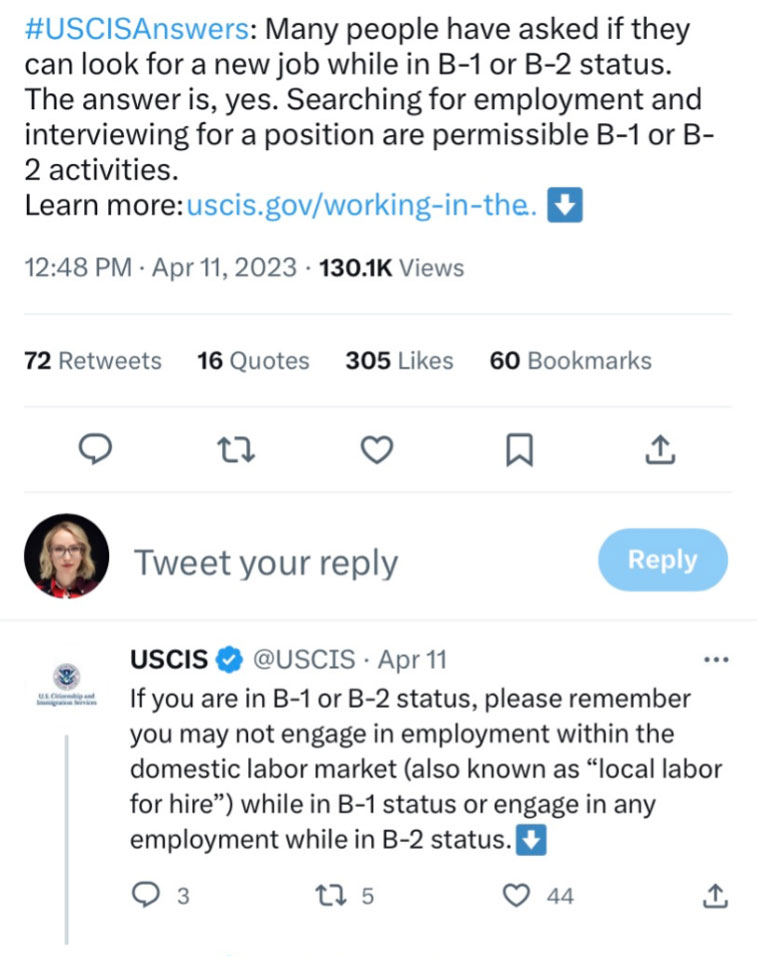Making Sense of USCIS’s Twitter Posts on Applying for Jobs or Attending Interviews While in Visitor Visa Status
By Cyrus D. Mehta and Kaitlyn Box*
On April 11, 2023, USCIS’s post on Twitter created a great deal of interest and some confusion. The tweet indicated that nonimmigrants can apply for jobs or attend job interviews while in B-1 or B-2 status. The post was the subject of numerous press articles, with some incorrectly interpreting it as a change in USCIS policy or authorization for B-1/B-2 visa holders to work in the United States.
The tweet read as follows: “Many people have asked if they can look for a new job while in B-1 or B-2 status. The answer is, yes. Searching for employment and interviewing for a position are permissible B-1 or B-2 activities.”
The USCIS clarified its response in a series of three additional tweets stating:
“If you are in B-1 or B-2 status, please remember you may not engage in employment within the domestic labor market (also known as “local labor for hire”) while in B-1 status or engage in any employment while in B-2 status”
“Before beginning any new employment, a petition and request for a change of status from B-1 or B-2 to an employment-authorized status must be approved, and the new status must take effect.”
“Alternatively, if the change of status request is denied or the petition for new employment requested consular or port of entry notification, the individual must depart the U.S. and be admitted in an employment-authorized classification before beginning the new employment.”
A screen shot of these tweets, the first of which received over 130,000 views, is reproduced below.

USCIS also linked to a page on its website entitled “Options for Nonimmigrant Workers Following Termination of Employment” that includes the following guidance:
Q: Can I look for a new job while in B-1 or B-2 status?
A: Yes, searching for employment and interviewing for a position are permissible B-1 or B-2 activities. By statute, however, you may not engage in employment within the domestic labor market (also known as “local labor for hire”) while in B-1 status or engage in any employment while in B-2 status. Before beginning any new employment, a petition and request for a change of status from B-1 or B-2 to an employment-authorized status must be approved, and the new status must take effect. Alternatively, if the change of status request is denied or the petition for new employment requested consular or port of entry notification, the individual must depart the United States and be admitted in an employment-authorized classification before beginning the new employment.
In a previous blog, we suggested that terminated noncitizen workers who needed to remain in the U.S. beyond the 60-day grace period could file a change of status to B-2.
9 FAM 402.2-5(B) lists activities that a B-1 visitor may engage in in the U.S., which include negotiating contracts, consulting with business associates, and participating in conferences or seminars. Visitors for pleasure may enter the United States for purposes including tourism, making social visits to friends or relatives, receiving medical treatment, and participating in social or religious activities pursuant to 9 FAM 402.2-4(A). The full scope of activities that are permissible under a B-1 or B-2 are often broader, however. So long as a noncitizen demonstrates the requisite ties to their home country and nonimmigrant intent, entering the U.S. on a B-1 or B-2 visa to attend interviews or apply for jobs was permissible even before USCIS issued its recent guidance on Twitter.
While it is commendable that the USCIS has correctly outlined this option for nonimmigrants who have been laid off, it remains to be seen how CBP will react if B-1/B-2 visa holders state that the purpose of their trip is attending a job interview or searching for employment in the U.S. CBP has broad powers to place visitors in expedited removal proceedings without a hearing if they determine that the person’s visit to the US is not consistent with the visitor admission. They can either initiate expedited removal if there is allegedly fraud or misrepresentation pursuant to INA 212(a)(6)(C) or lack of entry documents under INA 212(a)(7). CBP officials have been known to search phones and other electronic devices for hints that the person is looking for a job in the US and may not return timely. Other less-common uses of the B-1 visa, such as “B-1 in lieu of H-1B”, which allows individuals who would otherwise qualify for an H-1B visa to the United States for a limited period of time, have been the subject of ambiguity and legal challenges, as discussed in a prior blog.
The State Department could also interpret this differently from the USCIS and may deny a visitor visa to one who wishes to attend interviews or apply for jobs in the US. A US consular officer also has broad powers to refuse a visa under INA 214(b) that presumes that most nonimmigrant visa applicants are immigrants unless they can establish that they are entitled to the nonimmigrant status.
It would be nice if the USCIS, CBP and DOS coordinate the messaging on attending interviews or looking for jobs while someone is in the US as a visitor, but such coordination between the three agencies is rare and maybe it is best for potential visitors to obtain appropriate legal advice rather than rely on the USCIS Twitter feed and be prepared to advocate to the relevant authority that they will remain bona fide visitors even if they will be looking for jobs or attending interviews.
[This blog is for informational purposes and should not be relied on as a substitute for legal advice]
*Kaitlyn Box is a Senior Associate at Cyrus D. Mehta & Partners PLLC.





Leave a Reply
Want to join the discussion?Feel free to contribute!